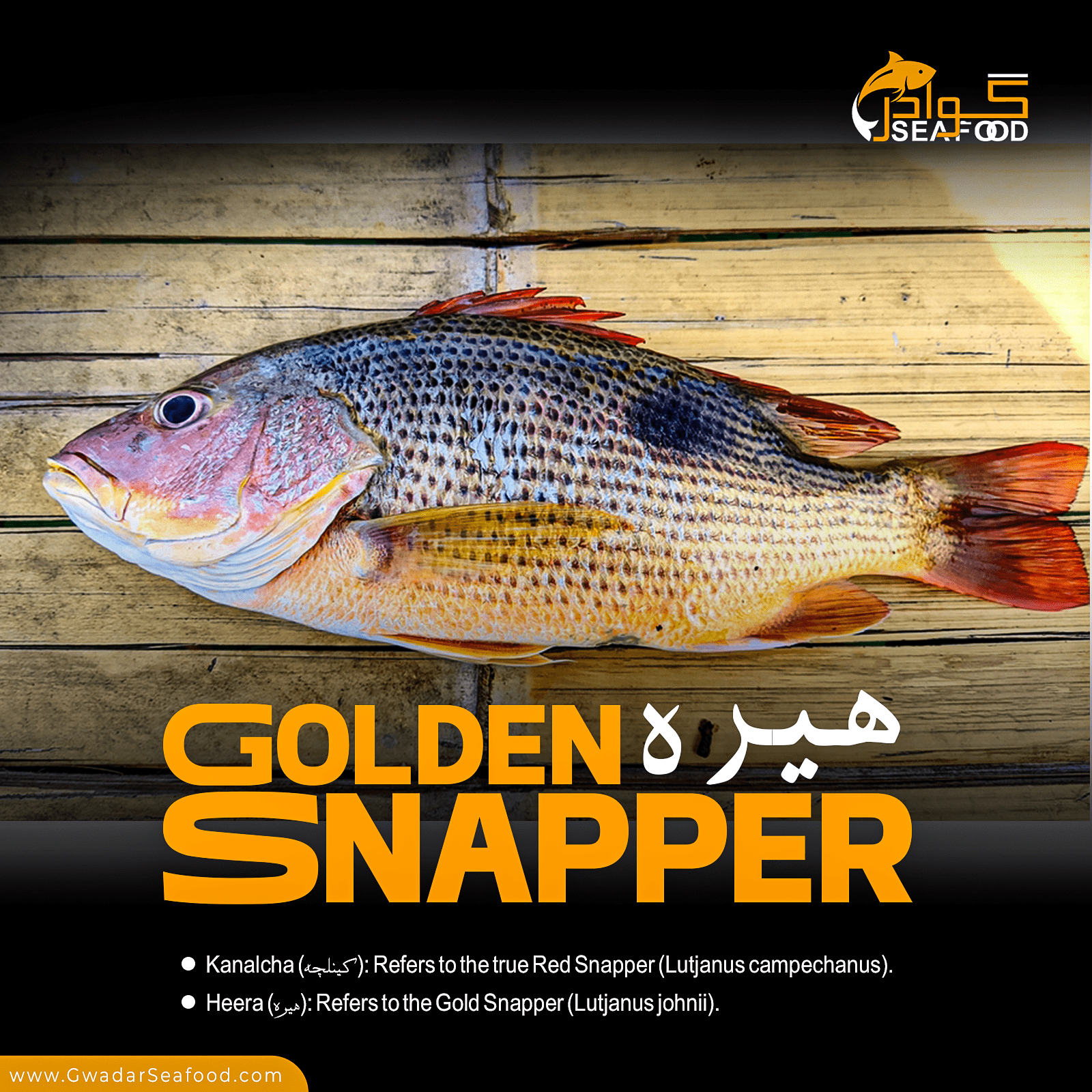Introduction
Heera (Lutjanus johnii), known as Golden Snapper, is a tropical fish found in the Indo-Pacific region. Unlike the real Red Snapper (Kanalcha), which is mistakenly called Heera in Pakistan, the Golden Snapper is lighter in color, featuring a golden-yellow skin and a delicate, mild flavor. While Heera is usually priced higher, Kanalcha (Red Snapper) is cheaper, yet many sellers sell Kanalcha as Heera to capitalize on the higher price. Heera (Golden Snapper) is ideal for light grilling and curries, while Kanalcha (Red Snapper) has a firmer, richer flavor, making it perfect for a variety of cooking methods.
-
Kanalcha (کینلچہ): Refers to the true Red Snapper (Lutjanus campechanus).
-
Heera (ہیرہ): Refers to the Gold Snapper (Lutjanus johnii).
Deep Dive: Habitat, Diet & Growth
Lutjanus johnii, or Golden Snapper, thrives in the tropical and subtropical waters of the Indo-Pacific region, including the Arabian Sea. These fish are typically found in coral and rocky reefs, as well as estuaries, at depths ranging from 0 to 80 meters.
Golden Snappers are carnivorous, feeding primarily on smaller fish, crustaceans, and cephalopods. They are known to inhabit shallow coastal waters, including mangrove areas, and are often found in turbid waters around reefs in muddy coastal regions.
Concise Addition: Spawning & Conservation
Golden Snapper is a moderately long-lived species, with a lifespan of up to 30 years. They reach sexual maturity at varying ages depending on geographical location, with some females maturing between 6 and 9 years. Golden Snapper (Lutjanus johnii) spawns during the warmer months, releasing millions of eggs that drift in surface currents. While overfishing is a concern in some regions, the species is not currently listed as threatened.
Names & Taxonomy
-
Common Name: Golden Snapper
-
Local Name in Pakistan: Heera (ہیرہ)
-
Scientific Name: Lutjanus johnii
-
Family: Lutjanidae
-
Order: Perciformes
-
Class: Actinopterygii
Note: In Pakistan, Lutjanus johnii is often referred to as “Heera,” while the true Red Snapper (Lutjanus campechanus) is sometimes mistakenly called “Heera.”
Sourcing & Catching Method
All Golden Snapper sold by Gwadarseafood is wild-caught in the deep waters of the Arabian Sea, primarily off the coasts of Karachi and Balochistan. Local fishermen use sustainable methods, including handlines and longlines, to catch the fish. After being caught, the fish is immediately chilled to maintain freshness. Processing is completed within hours of landing to ensure the highest quality and flavor.
Physical Traits & Texture
Golden Snapper has a sleek, streamlined body, characterized by its vibrant yellow to golden skin with a bronze to silvery sheen. The flesh is firm, dense, and slightly moist, offering a mild yet rich flavor that intensifies when cooked. The fish’s skin is vibrant yellow, making it a visually striking addition to any dish.
Cutting Options & Yields
| Option | Approx. Yield | Best For |
|---|---|---|
| Whole (uncleaned) | ~100% | Whole roasts or bulk processing |
| Gutted only | ~75–78% | Curry-style cuts |
| Headless & Gutted | ~65% | Large steak and fillet production |
| Steaks (bone-in) | ~68–70% | Grilling, pan-frying |
| Boneless fillets | ~45–48% | BBQ, oven-bake, sushi-grade use |
Cooking Ideas – Versatile, Rich & Crowd-Friendly
-
Grilled Golden Snapper: Marinate with olive oil, lemon, garlic, and herbs, then grill for a smoky, flavorful dish.
-
Pakistani Masala Golden Snapper: Simmer chunks in a spicy tomato-onion gravy with whole spices like cumin and coriander.
-
Golden Snapper Salad: Flake grilled Golden Snapper into a fresh salad with mixed greens, cucumbers, and a tangy lemon dressing.
-
Oven-Baked Golden Snapper: Roast with rosemary, thyme, and garlic for a simple yet flavorful dish.
-
Golden Snapper Sashimi: For sushi lovers, fresh cuts of Golden Snapper offer an exquisite raw dish.
Tips for Selecting Fresh Golden Snapper (Heera)
-
Flesh Color: Fresh Golden Snapper should have bright yellow to golden flesh, with no signs of browning or dullness.
-
Smell: Look for a mild ocean scent. A strong fishy odor indicates the fish may not be fresh.
-
Skin: The skin should be smooth, shiny, and free of blemishes.
-
Eyes: Clear, bright eyes are a good indicator of freshness.
Tips for Storing Golden Snapper
-
Refrigeration: Store at 0–4°C and consume within 1–2 days for the best taste and texture.
-
Freezing: To extend freshness, freeze Golden Snapper in airtight or vacuum-sealed packaging. Best used within 1–2 months.
-
Avoid Thawing and Refreezing: Repeated thawing and refreezing can negatively impact the quality of the fish.
Nutrition Highlights (per 100 g raw flesh)
-
Protein: ~20–22 g
-
Fat: ~3.5–4.5 g
-
Carbohydrates: 0 g
-
Sodium: ~50 mg
-
Omega-3 Fatty Acids: ~0.5–0.7 g
-
Selenium: ~30 µg
-
Calories: ~100–120 kcal
-
Calcium: ~15 mg
-
Iron: ~0.8 mg
-
Vitamin D: ~5.0 µg
-
Vitamin B-12: ~1.5 µg
Golden Snapper is an excellent source of high-quality protein, healthy fats, and essential vitamins and minerals, making it an ideal choice for a healthy, balanced diet.
Need Something Similar?
-
Red Snapper (Kanalcha): For a firmer texture and stronger flavor.
-
Javelin Grunter : Mild flavor, flaky texture, and ideal for grilling.

 Sea Fish
Sea Fish
Reviews
There are no reviews yet.